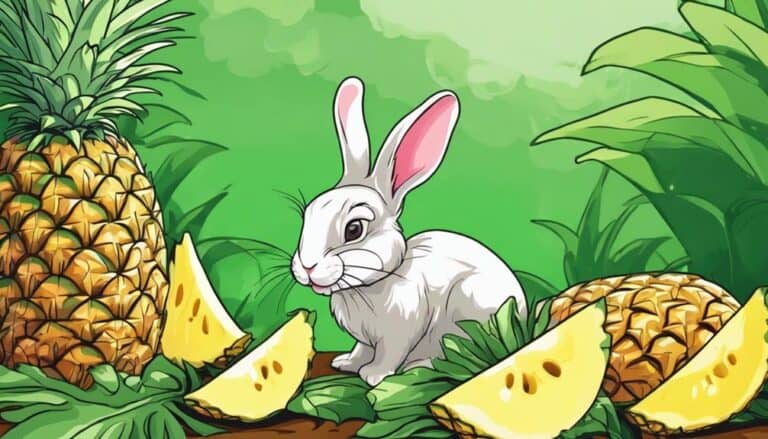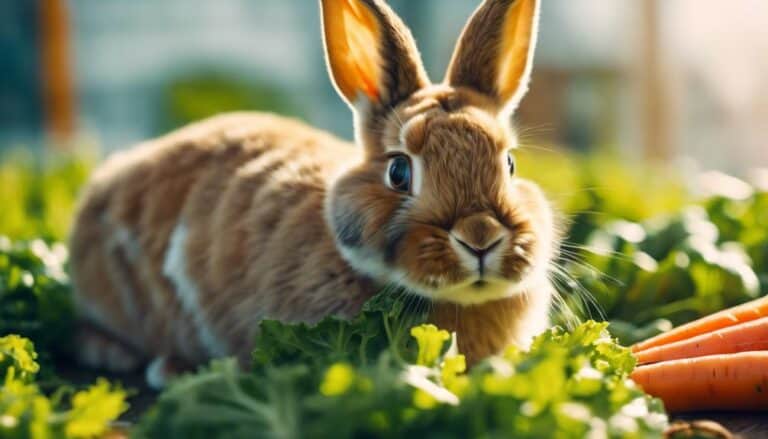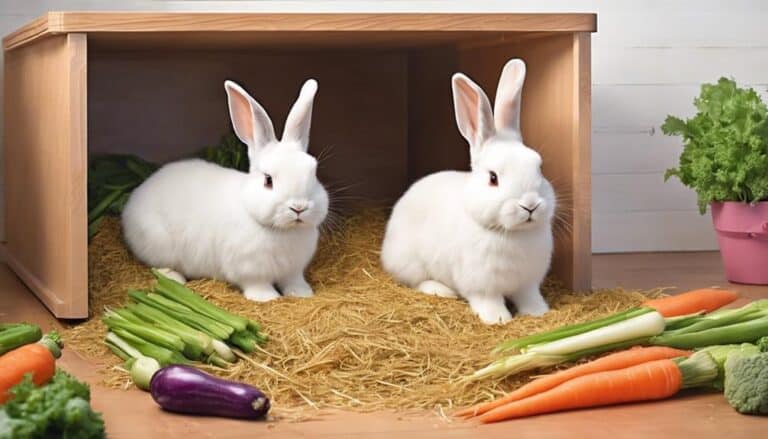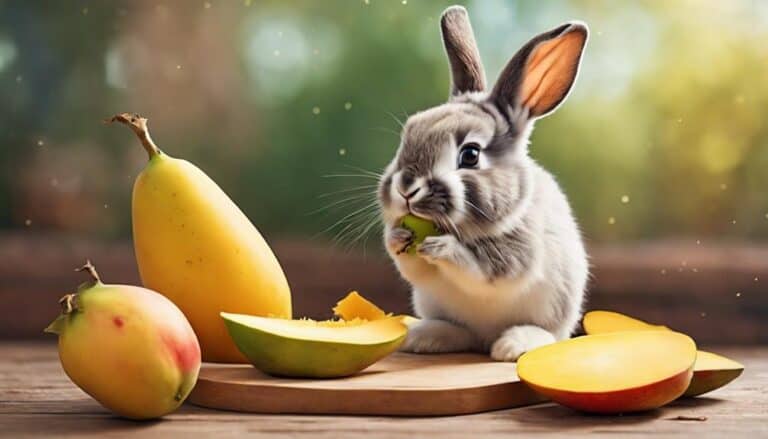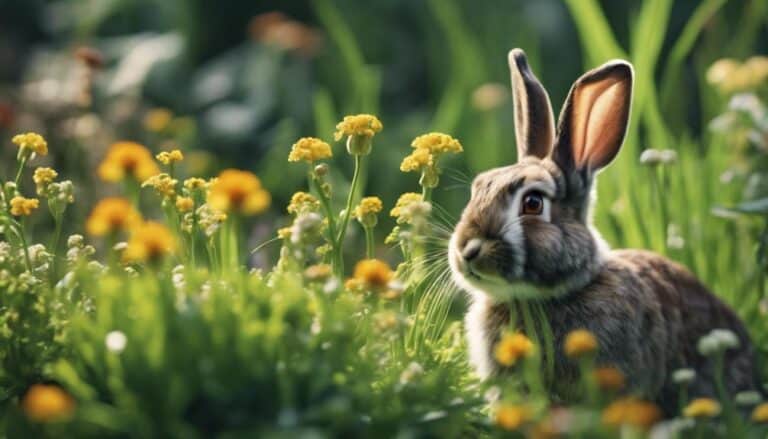One way to tell if your rabbit is happy is if they're bouncing around like crazy, doing those adorable little hops and flips called binkies. That's usually a good sign they're feeling pretty good.
But there's more to it than just their playful antics. You should also pay attention to how they interact with you and other rabbits. Do they seem relaxed and comfortable around you, or are they tense and jumpy?
Take a close look at their body language too. Are their ears up and alert, or are they laid back and relaxed? Do they seem to be enjoying their food, or are they picking at it half-heartedly?
And then there's their vocalizations. Rabbits make all sorts of sounds, from soft grunts to loud squeaks. If they're making happy sounds, like a gentle hum or a soft chuff, that's usually a good sign. But if they're making loud, high-pitched noises, that might be a sign of stress or discomfort.
Contents
Key Takeaways
So, you want to know if your rabbit is happy, right? Here's how to tell:
First, look for playful behavior. If your rabbit is hopping around, doing binkies (that's when they jump and twist in mid-air), or running around like crazy (we call that "zoomies"), that's a good sign they're feeling happy and carefree.
Next, observe their social interactions. Do they gently nudge you or their rabbit friends, or even groom them? That's a sign they feel comfortable and content around others. And if they're bonding with you or their fellow bunnies, that's even better!
Now, pay attention to their body language. Are their ears relaxed, and their eyes calm? Do they have an open posture, like they're not worried about anything? That's a great indication they're feeling happy and relaxed.
Also, listen to their vocalizations. Instead of loud, stressed-out sounds, do you hear soft humming or joyful squeaks? That's music to your ears, because it means your rabbit is feeling happy and content.
Finally, check their eating habits. Are they eating regularly, with a healthy appetite? Do they get excited during meals, like they can't wait to dig in? That's a good sign they're feeling happy and satisfied with their food.
Playful Behavior
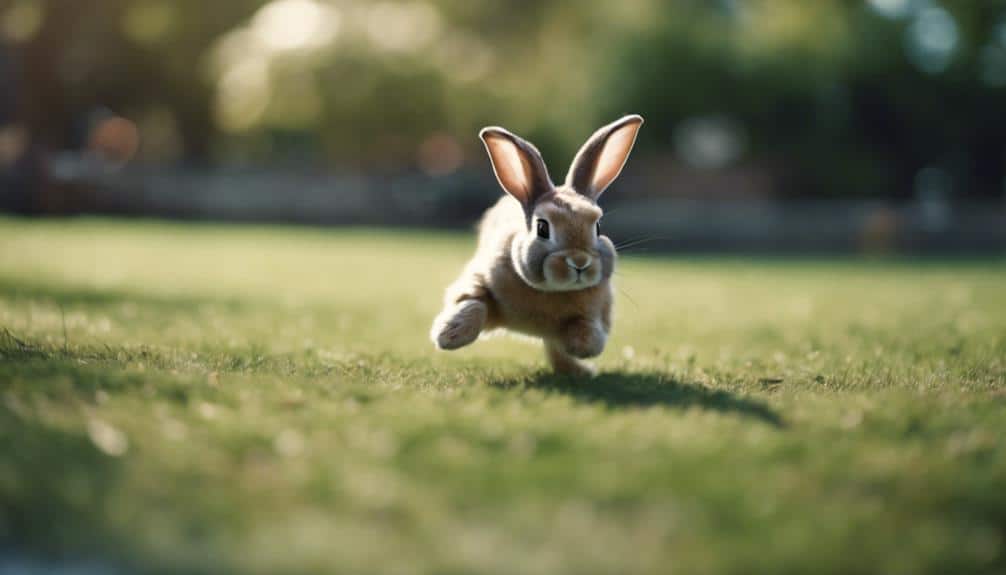
So, how can you tell if a rabbit is happy just by looking at their playful behavior?
Happy rabbits do all sorts of fun stuff that shows they're feeling content and joyful.
One super clear sign of a happy rabbit is when they start hopping, jumping, twisting, and binkying around.
This kind of playful behavior, including running around the room like crazy (we call it 'zoomies'), shows that a rabbit is really happy and doing well.
When a rabbit does a 'binky dance' after playing or eating, it's a strong sign that they're feeling good emotionally.
Playful rabbits also love to toss toys around, explore their surroundings, and check out new objects and smells.
They're really curious and get a lot of mental stimulation from doing these things.
You can tell they're super enthusiastic when they use their back legs to push off and jump with excitement.
Sometimes, they'll even get into a little gentle play-fighting.
By rearranging their environment and starting playtime with little nudges, rabbits show that they want to socialize and have fun.
This just adds to the evidence that they're happy, and it's all because of their playful behavior.
Social Interaction
It's really sweet to see your rabbit playing with other bunnies. This shows that they're social animals and enjoy interacting with each other.
When your rabbit starts doing binkies and running around with their friends, it's a clear sign that they're happy and feel comfortable around the other rabbits.
Rabbits also have a special way of bonding with each other – they groom each other. This is a sign that they trust and are content with their group. Grooming is not only a way for rabbits to maintain their hygiene but also serves as a form of communication and affection within their group. This behavior raises an interesting question: do rabbits show love for owners? Indeed, many rabbit owners report that their pets demonstrate affection through various behaviors, such as nuzzling, gentle nudging, and even following them around the house. These actions reflect a bond that goes beyond mere survival, indicating that rabbits can form strong attachments to their human companions as well.
Playtime With Others
Rabbits are social creatures that thrive on interaction. When they're around others, they show their happiness through gentle nudges and initiating interactions with their companions. These interactions are a key part of a rabbit's social life and are essential for their emotional well-being.
Rabbits display their affection and trust through gentle nudges, which are a clear indicator of their happiness. They also initiate interactions with others, which shows they're seeking social engagement and bonding. When rabbits are happy, they also engage in harmonious behaviors like grooming each other. This is a sign of strong social bonds and contentment.
Playful activities are another key indicator of a rabbit's happiness. When they're joyful and interacting with others, it's a clear sign they're feeling happy and content. Observing these social interactions can give you valuable insights into your rabbit's emotional state and help you ensure they're happy and comfortable in their environment.
Here's a table that highlights the key social behaviors that indicate a rabbit's contentment and well-being:
| Social Behaviors | Indicators of Happiness |
|---|---|
| Gentle Nudging | Affection and trust towards companions |
| Initiating Interaction | Seeking social engagement and bonding with others |
| Harmonious Grooming | Strong social bonds and contentment |
| Playful Activities | Joyful interactions and sense of well-being |
Binkying and Zoomies
Watching rabbits do binkying and zoomies is like seeing a whirlwind of happiness in action. It's a reflection of their social interactions and how happy they are.
When rabbits binky, they jump and twist in the air, which is a clear sign they're feeling great. It's like they're bursting with excitement and contentment, showing off their carefree side. And when they get the zoomies, dashing around with lots of energy, it's like they're performing a happy dance. They're showing us their playful side.
When a rabbit is happy, its body language is relaxed, and its movements are smooth and natural. These moments of binkying and zoomies often happen when they're interacting with their owners or other rabbits, which shows they've strong bonds and trust.
Grooming Each Other
Rabbits that are really close often groom each other as a way to show affection and connection. They do this by gently nuzzling, licking, and nibbling on each other's fur, all while looking super relaxed and calm. This behavior is a big indicator of how happy and content a rabbit is.
But every rabbit is different, and their grooming habits might vary. So, it's a good idea to pay attention to their body language when they're grooming. This can give you a sense of how comfortable and happy they are.
When rabbits groom each other, it does more than just strengthen their bond. It also helps reduce stress and anxiety, making them feel more at peace and relaxed. By doing this, they're showing trust and affection for each other, which is really important for their overall well-being.
If you're a rabbit owner, you should really pay attention to your rabbits' grooming behaviors. They can tell you a lot about their emotional health and how strong their social relationships are.
Body Language
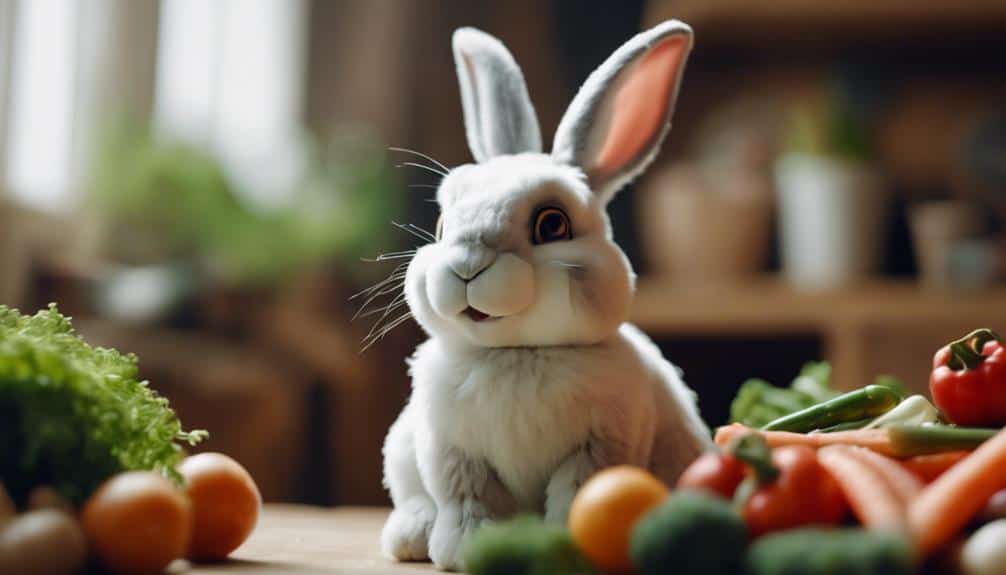
Want to know how your rabbit is feeling? Take a closer look at its body language. A happy and relaxed rabbit will display some pretty clear signs of contentment.
For starters, check out its ears. If they're in a neutral or slightly relaxed position, that's a good sign. It means your rabbit is feeling calm and not stressed out. Now, take a peek at its eyes. Are they bright, calm, and relaxed? That's what you want to see. If they're wide, fearful, or aggressive, something's amiss.
When your rabbit lies on its side, exposing its belly, that's a big indication of trust and contentment. Its whiskers will also give you a clue. If they're slightly forward, that means your rabbit is curious and not tense. Happy rabbits often have closed or half-closed eyes when they're resting, which suggests they feel safe and comfortable in their environment.
Take a step back and look at your rabbit's overall posture. Is it relaxed and open, or tense and closed off? A happy and secure rabbit will have a loose and open body stance. By paying attention to these body language cues, you'll get a better sense of how your rabbit is feeling and can take steps to promote its well-being.
Appetite and Eating Habits
Want to know if your rabbit is happy? Take a closer look at how it eats. If your rabbit is enthusiastic during mealtime and has clear food preferences, that's a good sign.
Tracking your rabbit's appetite and eating habits can tell you a lot about its overall well-being and happiness.
Eating Behavior Observation
When it comes to figuring out if your rabbit is happy, their appetite and eating habits can give you some big clues.
A happy rabbit is going to have a healthy appetite and get really excited when they see their favorite foods or treats. They'll eat with enthusiasm and might even do a little happy dance, known as a 'binky,' to show how thrilled they are.
Rabbits that are happy and content tend to eat at a steady pace, taking their time to enjoy their food and not rushing through meals. They'll also have regular and consistent eating habits, without being picky or refusing to eat.
By watching how your rabbit eats, you can learn a lot about their emotional state. Generally, happy rabbits love their meals and show it by being eager to dig in and savoring their food. They might even do a little binky to express how happy they are.
Food Preferences Tracking
Monitoring a rabbit's food preferences and eating habits is really important for understanding their overall health and happiness. When a rabbit is happy, they usually have a good appetite and enjoy their meals with enthusiasm.
Rabbits naturally eat frequently throughout the day, so it's vital to keep an eye on how much they're eating. A balanced diet that includes fresh veggies, fruits, hay, and pellets is perfect for a content rabbit. They tend to love Timothy hay and should only get high-calorie treats in moderation to stay at a healthy weight.
By tracking a rabbit's food preferences, you can spot any changes that might indicate underlying health issues, like dental problems or gastrointestinal disorders. These issues can affect a rabbit's happiness, so it's crucial to stay on top of their eating habits.
You might also notice changes in their behavior, like increased appetite due to stress or boredom. By paying attention to their food preferences, you can provide the best possible care for your rabbit and ensure they're happy and healthy.
Vocalizations
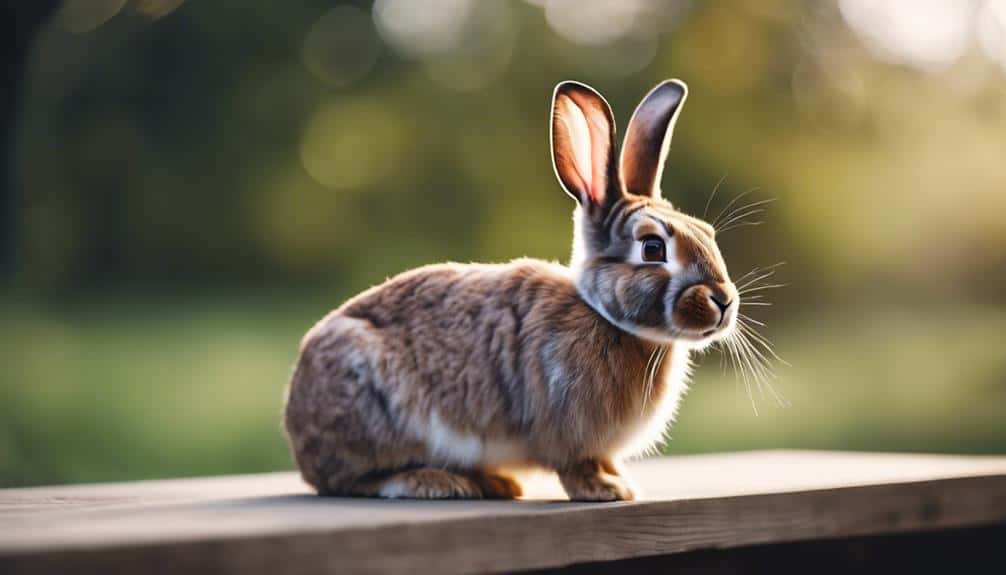
Rabbits communicate their emotions through various vocalizations, ranging from soft purring to high-pitched squeals. So, when you hear your rabbit making noises, pay attention – these sounds can give you valuable insights into their feelings.
Happy rabbits tend to produce soft, gentle sounds like humming, grunting, or soft squeaking, indicating they're content and relaxed. You might even hear a joyful, high-pitched squeak, known as a 'binky' sound, which is a clear sign of happiness, usually accompanied by celebratory jumps or twirls.
When rabbits feel relaxed and comfortable in their surroundings, they make soft sounds like 'chuffing' or 'chattering'. It's essential to understand your rabbit's vocalizations to gauge their emotional well-being and ensure they feel safe and secure in their environment.
Grooming Behavior
Rabbits show how happy and content they're through their grooming behavior. When they're feeling relaxed and happy, they'll often groom themselves and others as a way to show affection and strengthen their relationships.
Happy rabbits take their time when they groom, making sure every part of their body is clean and well-maintained. They do this with a sense of calmness and precision, which not only keeps their fur looking good but also helps them relax and feel good about themselves.
When rabbits groom each other, it's a sign that they trust and care about each other. If you see rabbits grooming each other, it's usually a good sign that they're happy and have strong bonds with each other. However, it's important to keep an eye out for any changes in their grooming behavior. If they're grooming too much or pulling out their own fur, it could be a sign that they're stressed or unhappy.
Environmental Exploration
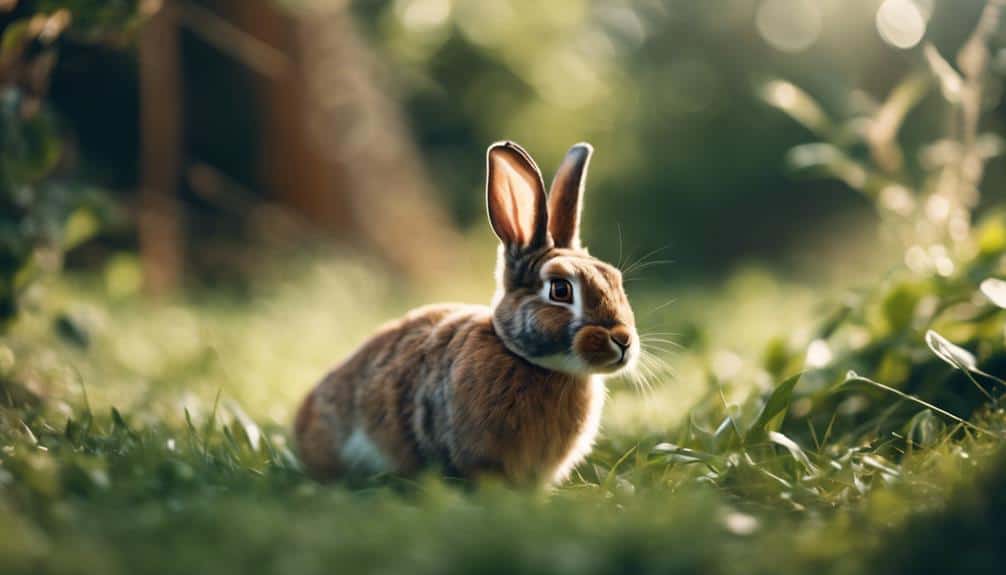
So, have you ever watched happy rabbits play? They're really into exploring their surroundings and having fun with toys. This kind of exploration is super important for their happiness – it lets them use their natural instincts and stay mentally sharp.
You might see them running around like crazy, darting from one corner to another. They're just so full of joy and excitement! They might also hop around objects in circles, which shows how curious they're and how much they want to check out everything around them.
Some rabbits even twist in the air when they're playing or exploring. That's a sign they're feeling really free and comfortable in their environment.
Watching your rabbit do these things can give you a sense of how they're feeling emotionally. It can also give you ideas for how to make their environment even better, so they can stay happy and content.
Overall Well-being
Observing their behavior and body language can give you some big clues about whether your rabbit is happy and thriving.
When a rabbit is relaxed, they'll often lie down with their legs stretched out, roll onto their backs, or flop onto their sides. Their ears will be relaxed and laid back, not perked up or tense. Their eyes will have a soft, calm gaze, bright, and alert. You might also notice slow, deliberate movements, like getting up or changing positions slowly.
A happy rabbit's posture will be loose and open, showing a relaxed body that isn't tense or stiff. Sometimes, they'll even lie on their side, expose their belly, and have closed or half-closed eyes while resting. This is their way of saying, 'Hey, I'm feeling great!'
A rabbit's overall well-being is closely tied to its body language and behaviors. So, keep an eye out for these signs to know your bunny is content and thriving.
Conclusion
So, you want to know if your rabbit is happy? Observing their behavior can give you a pretty good idea.
A happy rabbit is kind of like a work of art – they're playful, social, and relaxed. If you pay attention to how they're behaving, you can get a sense of their emotional well-being.
For example, look at their body language. Are they tense or relaxed? Do they seem to be enjoying themselves when they're playing or eating?
Also, listen to the sounds they make. Rabbits make different noises when they're happy or upset.
Another thing to check is their grooming habits. Happy rabbits tend to keep themselves clean and well-groomed.
And finally, just observe their overall enthusiasm for life. Are they curious and interested in their surroundings, or do they seem bored or uninterested?
By paying attention to these things, you can get a sense of whether your rabbit is living their best life.

